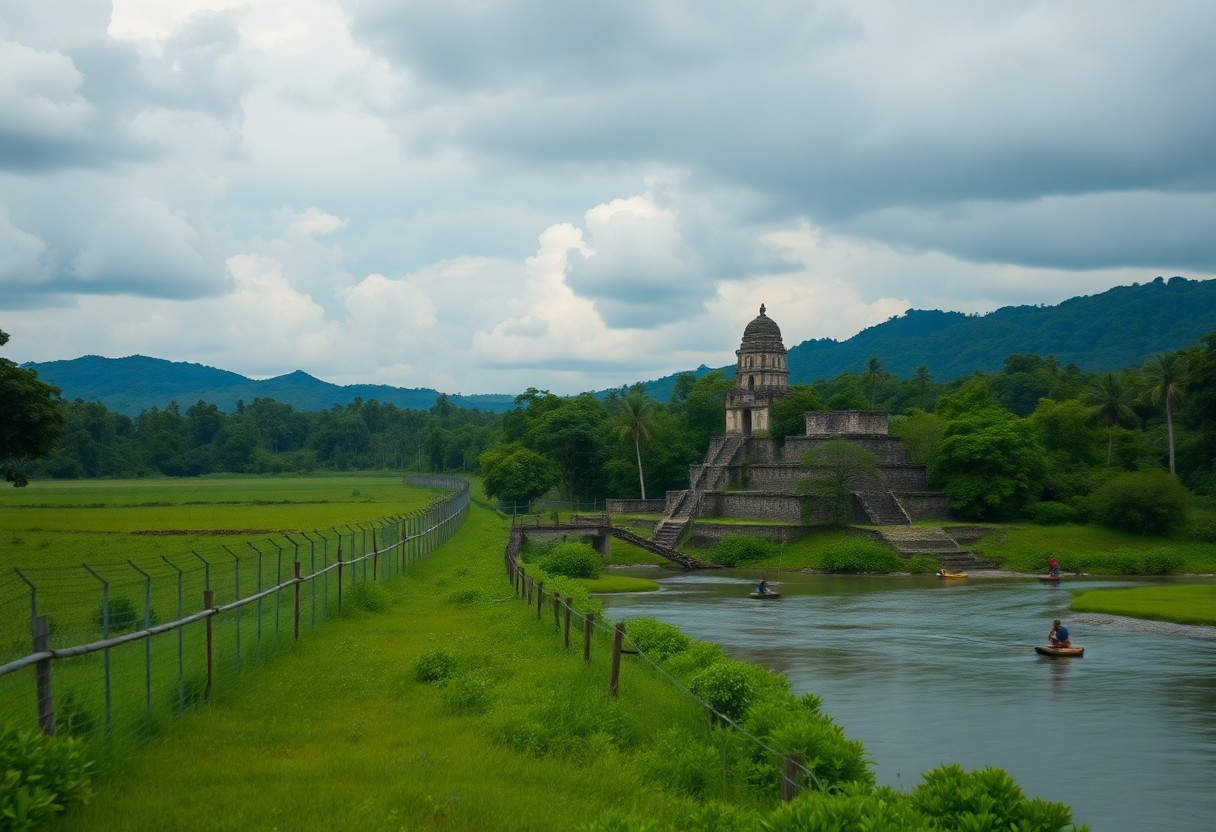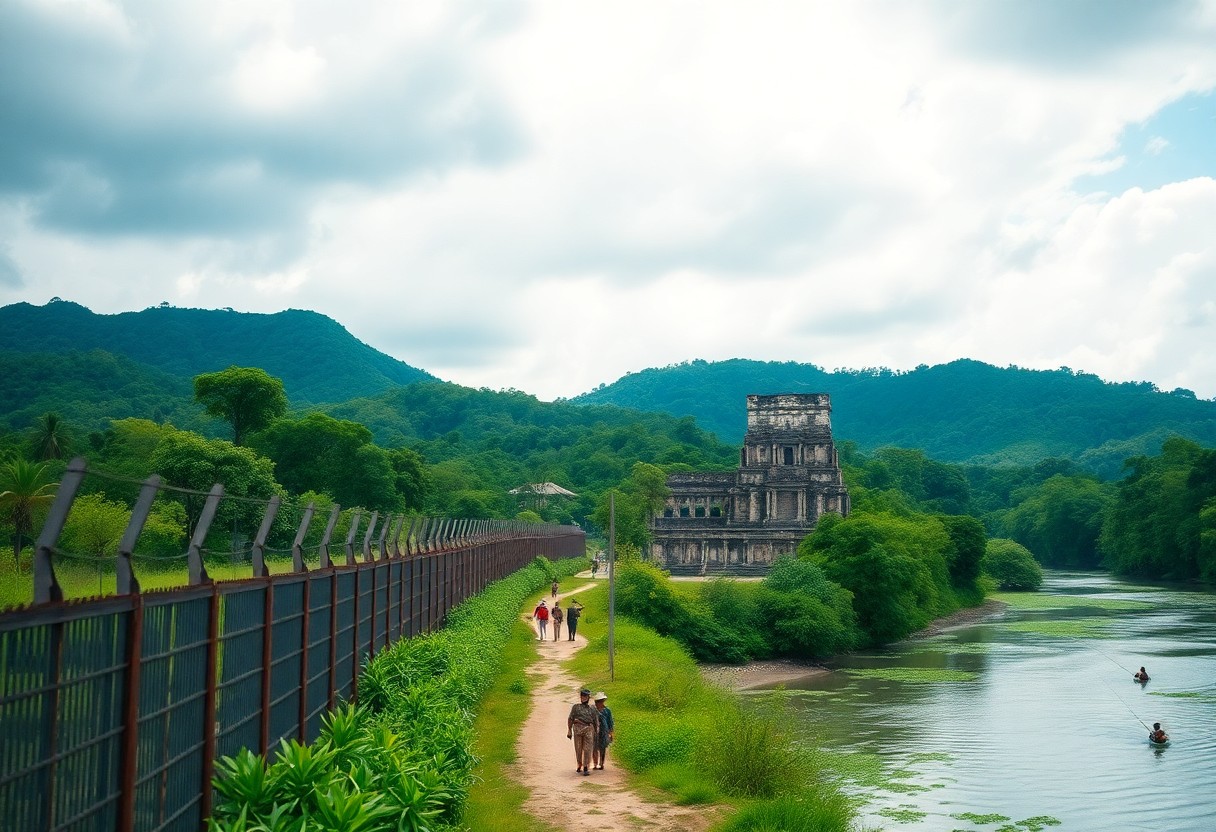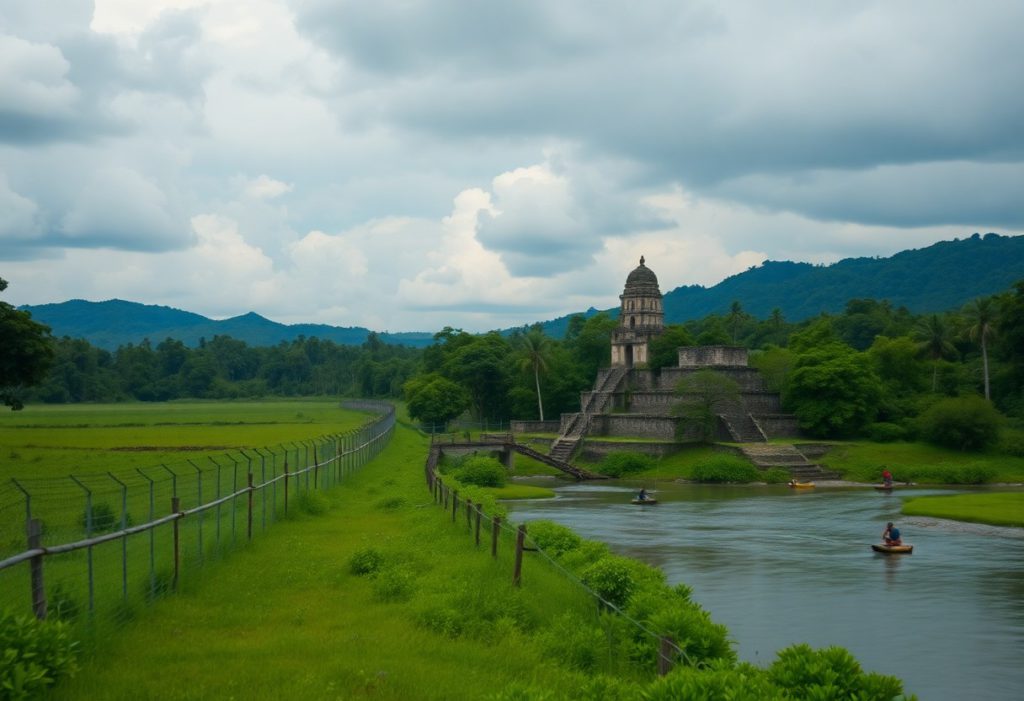The intricate and multifaceted territorial dispute between Belize and Guatemala represents a long-standing geopolitical tension that has evolved over centuries, revealing layers of complexity that continue to surprise observers. This enduring border conflict, deeply entrenched in colonial-era claims, poses a significant threat to regional stability. Since gaining independence, Guatemala has persistently contested Belize’s sovereignty, leading to decades of diplomatic friction and escalating tensions. However, recent developments have sparked a glimmer of hope for a peaceful resolution. Notably, the landmark 2019 referendum, in which both nations agreed to settle their differences through the International Court of Justice, marks a potential turning point in their contentious relationship. Understanding the intricate history of this border is crucial for grasping the broader geopolitical dynamics of Central America.

Delving into the Colonial Roots of the Belize-Guatemala Dispute
The multifaceted nature of the territorial disagreement between Belize and Guatemala has its origins in colonial-era territorial claims, propelled by the imperial ambitions of Spain and the expansionist policies of Britain. The dispute traces back to the competing interests of European powers vying for control over Central America, with both nations laying claim to strategically valuable territories. These unresolved boundary issues have transformed into a persistent source of tension, reflecting the complex historical dynamics that underpin territorial sovereignty in the region. The enduring legacy of these colonial claims continues to impact the political landscape, underscoring how historical grievances have lasting effects on contemporary diplomatic relations.
Analyzing the Lasting Effects of the 1859 Boundary Treaty
In the context of imperial negotiations, the 1859 Boundary Treaty between Britain and Guatemala sought to delineate territorial borders. However, instead of providing clarity, this agreement has inadvertently complicated matters further. The treaty's ambiguous language and various interpretations have become a fundamental source of ongoing territorial disputes between the two nations. The complexities surrounding this treaty highlight the enduring impact of colonial agreements on current conflicts, as Belize and Guatemala continue to wrestle with the far-reaching implications of historical treaties that shape their present. Understanding these legal intricacies is key to addressing the ongoing challenges both nations face.
Tracing the Historical Context of Territorial Negotiations
From the era of Spanish colonial dominance to the establishment of modern nation-states, the landscape of territorial negotiations has been anything but straightforward. The geopolitical dynamics of the region were significantly influenced by imperial rivalries and the fluctuating boundaries of colonial territories, laying the groundwork for future conflicts. These boundary disputes reflect a broader narrative involving colonial legacies and postcolonial territorial challenges. The strategic importance of the territory has historically fueled conflicts, as Guatemala routinely contests Belize’s claims to sovereignty. This multifaceted dispute encompasses crucial issues of historical interpretation, indigenous rights, and territorial integrity, rendering it a complex international issue that continues to shape diplomatic relations between the two nations.
Exploring the Core Issues Faced in the Belize-Guatemala Border Dispute
The intricate border dispute between Belize and Guatemala encompasses a wide array of historical, territorial, and political dimensions. Significant tensions arise from competing claims over land, sovereignty, and differing interpretations of history. This conflict, deeply rooted in colonial borders, has been perpetuated by international legal disputes and enduring nationalist sentiments, presenting formidable challenges within the diplomatic landscape for both nations. Gaining a comprehensive understanding of these core issues is essential for addressing the complexities of the dispute and working toward a resolution that acknowledges and respects the interests of both countries.
Guatemala’s Persistent Assertion of Territorial Claims
At the heart of the dispute, Guatemala asserts claims to approximately 12,000 square kilometers of Belizean territory, framing its historical rights as rooted in Spanish colonial boundaries. These claims challenge the legitimacy of British territorial acquisitions, emphasizing interpretations of historical treaties and colonial agreements that Guatemala argues were implemented unfairly. This assertion reflects Guatemala's ongoing struggle to reclaim what it considers ancestral land, highlighting the deep-seated grievances that continue to fuel the dispute and illustrating the need for a nuanced approach to resolution that addresses historical injustices.
Defending Belize's Sovereignty and Territorial Rights
The discourse surrounding Belizean sovereignty underscores the nation's right to self-determination and the protection of its territorial integrity. Belize firmly asserts its independence and categorically rejects Guatemala’s territorial claims, emphasizing the importance of international recognition and the legal principle of uti possidetis juris, which supports the maintenance of existing colonial boundaries post-independence. A deeper exploration reveals that Belize’s sovereignty is fortified by international law and numerous United Nations resolutions. The nation has consistently advocated for its territorial integrity through diplomatic channels and by garnering international support to strengthen its borders. Moreover, peaceful resolution mechanisms, including international mediation, have emerged as critical strategies in addressing this long-standing dispute.

Examining Diplomatic Efforts Toward Conflict Resolution
The ongoing efforts to resolve the enduring border conflict between Belize and Guatemala have involved various international mechanisms and negotiation strategies. Both nations are acutely aware of the potential risks associated with prolonged territorial tensions, prompting them to seek peaceful solutions through diplomatic channels. International mediation and bilateral discussions have proven instrumental in gradually easing historical animosities and paving the way for resolution. Understanding these diplomatic initiatives sheds light on the progress achieved and the challenges that remain on the journey towards achieving lasting peace.
Insights into the Diplomatic Negotiation Process
The diplomatic negotiations between Belize and Guatemala have been marked by incremental progress and strategic dialogue aimed at enhancing mutual understanding. These discussions have sought to explore potential compromise solutions that could accommodate the interests of both nations. Key diplomatic initiatives have included high-level meetings, the establishment of bilateral commissions, and international facilitation, all aimed at addressing territorial claims and fostering regional stability. This ongoing dialogue underscores the critical role of diplomacy in resolving complex geopolitical issues that affect both countries.
The Crucial Role of the International Court of Justice
The International Court of Justice (ICJ) plays an essential role in mediating the border dispute between Belize and Guatemala. The ICJ provides a neutral legal platform for addressing territorial claims, offering an internationally recognized mechanism for dispute resolution that has the potential to resolve decades of territorial tensions. The court's involvement signifies more than mere arbitration; it represents a critical turning point in the relationship between Belize and Guatemala. By agreeing to submit their dispute to the ICJ, both countries have demonstrated a commitment to pursuing a peaceful resolution. The forthcoming ruling from the court could definitively clarify territorial boundaries, potentially establishing a permanent legal framework for future bilateral relations and contributing to regional stability.

Understanding the Implications for Travel and Trade between Countries
Navigating the complex Belize-Guatemala border requires a comprehensive understanding of its multifaceted challenges. The historical territorial disputes have significant repercussions on cross-border interactions, shaping unique travel and economic dynamics. The ongoing tensions have influenced transportation routes, trade patterns, and the diplomatic relations between these neighboring countries. The border region requires careful consideration of geopolitical sensitivities that could impact movement and economic exchanges, making it essential for travelers to stay informed and adequately prepared for their journeys.
Current Travel Guidelines for Safety and Awareness
Traveling along the Belize-Guatemala border necessitates exercising heightened caution. Your safety greatly depends on staying informed about current diplomatic conditions and potential conflict zones. Official travel advisories recommend checking government websites prior to crossing, verifying essential documentation, and being aware of the local security situations. Careful route planning, including using official border crossing points, can minimize risks and enhance your travel experience in this sensitive region where tensions may arise unexpectedly.
Analyzing Cross-Border Trade Dynamics and Economic Interdependence
The trade relations between Belize and Guatemala at the border remain intricate and continually evolving. Despite historical tensions, agricultural products and small-scale commercial exchanges persist, reflecting the economic interdependence that continues to exist between these two nations. To fully understand these interactions, one must recognize the resilience of economic relationships that endure despite political challenges. The trade landscape unveils a complex web of interactions where agricultural commodities such as sugar, citrus, and timber play significant roles in cross-border exchanges. Informal trade networks, facilitated by local merchants, navigate the diplomatic complexities, highlighting how economic cooperation can thrive amidst territorial disputes. Ongoing bilateral agreements and diplomatic negotiations continue to shape these economic interactions, offering promising prospects for future collaboration and mutual benefits.
Examining the Socio-Political Effects of the Dispute
The border dispute between Belize and Guatemala extends well beyond mere geographical lines, embodying profound socio-political implications for both nations. This territorial conflict significantly influences diplomatic relations, national security strategies, and broader regional dynamics. The ongoing tensions create complex socio-political challenges that shape governmental strategies, international negotiations, and the daily lives of citizens in both countries. Gaining insight into these implications is vital for comprehending the broader effects of the dispute on the region and the potential paths toward resolution.
National Identity and Public Sentiment Surrounding the Dispute
The border dispute deeply resonates with national pride and historical narratives in both Belize and Guatemala. Each country perceives the territorial claims as a matter of fundamental sovereignty, leading to impassioned public discourse and political sentiment. This conflict has morphed into a symbol of national identity, as citizens fervently defend their historical perspectives and territorial integrity. The emotional weight of these claims significantly shapes public opinion, influencing political discourse and national policy, thereby emphasizing the intricate relationship between territorial disputes and national identity in both nations.
Assessing Regional Stability and Security Challenges
The ongoing border dispute presents potential vulnerabilities in regional peace and cooperation. Unresolved territorial claims generate diplomatic tensions that could destabilize bilateral relationships and impact broader regional security dynamics. Acknowledging these challenges is crucial for understanding the complex geopolitical landscape of Central America. The dispute represents more than a mere territorial disagreement; it threatens regional stability through the risk of military escalations. The persistent tension complicates economic cooperation, cross-border trade, and collaborative security efforts. Awareness of these dynamics elucidates how unresolved territorial claims can undermine diplomatic progress and create long-term challenges for peaceful coexistence between Belize and Guatemala.
Envisioning Future Opportunities for Resolution
Despite the complex historical tensions, the situation along the Belize-Guatemala border presents potential pathways for diplomatic resolution. Ongoing negotiations and international mediation offer a promising avenue for achieving a peaceful settlement. The international community remains supportive of constructive dialogue between both nations, suggesting that a comprehensive resolution may be within reach in the coming years. The commitment to diplomacy signifies a crucial step toward addressing longstanding grievances and fostering a more stable future for both nations.
Identifying Viable Resolutions to the Dispute
Resolutions to the enduring territorial dispute could involve international arbitration or a mutually agreed-upon territorial compromise. Observing the recent willingness of both countries to engage in diplomatic discussions suggests that a mutually beneficial agreement may be on the horizon. The involvement of neutral international bodies could provide a structured framework for addressing historical claims, paving the way for more effective conflict resolution strategies that benefit both nations.
The Impact of International Relations on Border Negotiations
International relations play a significant role in shaping the border negotiations between Belize and Guatemala. Diplomatic channels have emerged as vital tools for managing territorial tensions and fostering constructive dialogue. Regional organizations and global diplomatic platforms continue to facilitate discussions and seek peaceful solutions. Additionally, the broader geopolitical context influences these border relations, as international pressure and diplomatic engagement create opportunities for resolution. The potential for economic cooperation, joint development projects, and shared security interests presents promising avenues for collaboration. Organizations such as the OAS have been instrumental in mediating discussions and promoting peaceful interactions between the two nations, contributing to the ongoing efforts toward resolution.
Frequently Asked Questions About the Belize-Guatemala Territorial Dispute
What is the Historical Background of the Territorial Dispute between Belize and Guatemala?
The territorial dispute originates from Spanish colonial claims and British settlements in the region during the 19th century. Spain initially claimed the territory, but Britain established settlements in Belize, leading to complex legal and territorial challenges. The conflict centers on competing territorial assertions, with Guatemala maintaining claims to much of Belize’s land following Central American independence in 1821.
How Did the International Community Aid in Resolving the Long-standing Border Conflict?
The Organization of American States (OAS) has played a significant mediation role. In 2008, both countries agreed to submit the dispute to the International Court of Justice (ICJ) for a binding resolution. A referendum held in both Belize and Guatemala during 2018-2019 demonstrated public support for international judicial intervention, ultimately paving the way for a peaceful resolution mechanism.
What is the Current Status of the Belize-Guatemala Border Agreement?
In May 2019, the ICJ issued a definitive ruling on the territorial dispute, largely affirming Belize’s sovereignty while making minor adjustments to the border demarcation. The ruling granted Belize approximately 12,272 square kilometers of territory, providing a clear legal framework for future diplomatic relations and establishing permanent maritime and land boundaries between the two nations.
The Article The Belize-Guatemala Border: History, Conflict, and Current Status appeared first on Belize Travel Guide
The Article Belize-Guatemala Border: Historical Conflicts and Current Status Was Found On https://limitsofstrategy.com



It’s fascinating how the Belize-Guatemala dispute encapsulates the long shadows cast by colonialism in the present day. The 2019 referendum was indeed a pivotal moment, showing a willingness from both sides to seek a peaceful resolution rather than clinging to historical grievances. I wonder how the public’s perception of the dispute has evolved since then? Has there been a shift in national identity for Belizians and Guatemalans that might foster cooperation rather than conflict?
You make a great point about how the Belize-Guatemala dispute reflects colonial legacies that are still very much alive today. The 2019 referendum really was a telling moment, showcasing a collective desire to move beyond the bitterness of history. It’s like both sides realized that holding onto past grievances isn’t going to benefit anyone today.
Absolutely! To delve deeper into this evolving dynamic and the shifts in national identity for both Belizians and Guatemalans, check out our latest insights here.
https://metickets.co.uk/quillbot